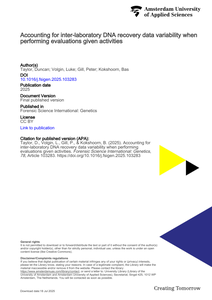A large, recently published, inter-laboratory study by the ReAct group has shown that there is considerable variability in DNA recovery that exists between forensic laboratories. The presence of this inter-laboratory variability presents issues when one laboratory wishes to carry out an evaluation and needs to use the data produced by another laboratory. One option proposed by the ReAct group is for laboratories to carry out a calibration exercise so that appropriate adjustments between laboratories can be made. This will address some issues, but leave others unanswered, such as how to make use of the decades of transfer and persistence data that has already been published. In this work we present a method to utilise data produced in other laboratories (whether it provides DNA amounts or a probability of transfer) that takes into account inter-laboratory variability within an evaluation. This will allow evaluations to continue, without calibration data, and ensures that the strength of findings is appropriately represented. In this paper we discuss complicating factors with the various ways in which previous data has been reported, and their limitations in supporting probability assignments when carrying out an evaluation. We show that a combination of producing calibration information for new data (as suggested by the ReAct group) and development of strategies where calibration data is not available will provide the best way forward in the field of evaluations given activities.
DOCUMENT

There appears to be some hesitation within the forensic biology community to formally evaluate and report on findings given activity level propositions. This hesitance in part stems from concerns about the lack of relevant data on the dynamics of biological traces and doubt about the relevance of such expert opinions to the trier of fact. At the Netherlands Forensic Institute formal evaluative opinions on the probability of case findings given propositions at the activity level are provided since 2013, if requested by a mandating authority. In this study we share the results from a retrospective analysis of 74 of such requests. We explore which party initiates requests, the types of cases that are submitted, the sources of data being used to assign probabilities to DNA transfer, persistence, prevalence and recovery (TPPR) events, the conclusions that were drawn by the scientists, and how the conclusions were used by the courts. This retrospective analysis of cases demonstrates that published sources of data are generally available and can be used to address DNA TPPR events in most cases, although significant gaps still remain. The study furthermore shows that reporting on forensic biology findings given activity level propositions has been generally accepted by the district and appeal courts, as well as the other parties in the criminal justice system in the Netherlands.
DOCUMENT

Considering activity level propositions in the evaluation of forensic biology findings is becoming more common place. There are increasing numbers of publications demonstrating different transfer mechanisms that can occur under a variety of circumstances. Some of these publications have shown the possibility of DNA transfer from site to site on an exhibit, for instance as a result of packaging and transport. If such a possibility exists, and the case circumstances are such that the area on an exhibit where DNA is present or absent is an observation that is an important diagnostic characteristic given the propositions, then site to site transfer should be taken into account during the evaluation of observations. In this work we demonstrate the ways in which site to site transfer can be built into Bayesian networks when carrying out activity level evaluations of forensic biology findings. We explore the effects of considering qualitative vs quantitative categorisation of DNA results. We also show the importance of taking into account multiple individual’s DNA being transferred (such as unknown or wearer DNA), even if the main focus of the evaluation is the activity of one individual.
DOCUMENT
